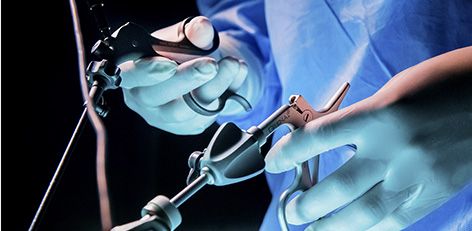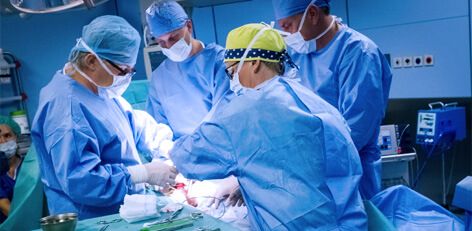Robotic-assisted radical prostatectomy is the most modern and most technologically advanced method of prostate cancer treatment.
We invite you to watch movies with the participation of our experts.
A three-dimensional surgical field visualisation, 10x magnification and the exceptional da Vinci robot’s precision allow the urologist to operate with an accuracy that no other method of prostate cancer treatment can match. This precision is especially important in treating prostate cancer, because it allows the surgeon to avoid damaging the critical local neurvascular structures and unpleasant complications associated with this damage, such as urinary incontinence and erectile dysfunction. Other benefits of robot-assisted radical prostatectomy, in comparison with other surgical prostate cancer treatment methods are faster resumption of normal activity, shorter hospitalization time and a lower risk of surgical complications, lower blood loss and less post-operative pain.
The da Vinci method - who performs the procedure
The patient will be under the care of one of three dedicated teams of operators:
- Artur A. Antoniewicz, MD, PhD and Artur Przewor, MD, PhD
- Tomasz Borkowski, MD, PhD and Daniel Leszczyński, MD
- Albert Gugała, MD and Daniel Leszczyński, MD
The entire procedure is always supervised by our Medical Director Marek Filipek, MD, PhD and Stefan W. Czarniecki, MD Head of the Department of Urology.
The da Vinci method - what is included in the service
The service includes the following items:
- treatment performed using the Robotic Da Vinci method - always with a team of 4 dedicated doctors, leading Polish urologists with many years of experience and expert knowledge. Chief Operator Artur Antoniewicz, MD, PhD or Tomasz Borkowski MD, PhD.
- stay at the Urology Department of the St. Elizabeth Hostpial.
- support of a dedicated patient coordinator Joanna Sitnik or Barbara Szczepańska (7 days a week)
- constant medical care, night duty performed by a urologist, specializing in postoperative care of patients undergoing the da Vinci method
- full board during the stay
- post-operative upright standing with a dedicated physiotherapist
- postoperative physiotherapy education - physiotherapist Martyna Romanowska-Naimska
- developing a diet tailored to the patient's needs - dietitian, Żaneta Rybak, MA
- visit to remove the catheter
- histopathological result of material collected during surgery
- postoperative follow-up consultation with Marek Filipek, MD, PhD or Stefan Czarniecki, MD
The stay is planned from the day of the surgery until 2 or 3 days after the surgery - the duration of the stay may change according to the recommendations of our medical team.
The da Vinci method - where do we perform the da Vinci method?
In the Urology Department of the St. Elizabeth Hospital.
Address: Warsaw, Sweryna Goszczyńskiego 1 Street
The da Vinci method - how to prepare?
The planned surgery must be preceded by appropriate diagnostics: Magnetic Resonance Imaging and Biopsy (both of these tests can be performed at HIFU CLINIC), and then a qualifying visit to one of our doctors takes place. After such a visit, we set a date for the operation, the waiting time is about 2 weeks.
The basis for qualification for prostate cancer surgery assisted by the Da Vinci Robot are primarily oncological indications according to the EAU and AUA standards (European and American Association of Urology).
It is determined in equal measure by the patient's safety as defined by our experts and the anesthesiologist in the context of robotic surgery.
We are guided by the choice of the most effective oncological therapy tailored to the specific clinical case presented by our patient, in which the operation using the Da Vinci Robot is of exceptional importance.
Additional prerequisites include:
- Internal medicine consultation
- Anesthesiology consultation
- RT-PCR test for COVID 19 - the preferred day to perform the test is Thursday or Friday before admission to the hospital
- Outpatient examinations 10 days before the procedure
All the above activities and tests can be performed at HIFU CLINIC with the help of Joanna Sitnik or Barbara Szczepańska.
What is the da Vinci method?
Thanks to the visualization of the operating field in a three-dimensional image, 10x magnification and the exceptional precision of the da Vinci robot, the urologist has the ability to operate with an accuracy that no other method of surgical treatment of prostate cancer can provide.
This precision is particularly important in the treatment of prostate cancer, because it helps avoid damage to the urethral sphincter and the vascular-nerve bundles located near the prostate and subsequently the related unpleasant complications, such as urinary incontinence or erectile dysfunction. The use of the da Vinci robotic surgery, compared to other methods of surgical treatment of prostate cancer, brings many benefits.
The most important ones include: faster return to normal activity, relatively short hospitalization time, lower risk of complications after the procedure, less blood loss and less pain, greater comfort for the operator during the procedure.
The da Vinci method, or radical prostatectomy assisted by the da Vinci robot, is a minimally invasive method of treating prostate cancer. It consists of the removal of the diseased prostate gland along with the seminal vesicles and, in some cases, also in the removal of lymph nodes. The procedure is performed by creating five access points, 0.5 to 2 cm in size, on the skin of the abdomen, through which the robot's arms are introduced into the patient's body. One of the arms contains a stereoscopic camera, which allows to obtain a three-dimensional image of the operating field. The remaining arms support surgical instruments. The surgeon operates the robot from the console, which translates its movements into much more precise maneuvers of the robot's arms and avoids unintentional movements, for example, trembling of the operator's hands. The arms of the da Vinci medical robot are also much more mobile than the tools used in traditional laparoscopic prostatectomy.
What is robotic-assisted radical prostatectomy?
Robotic-assisted radical prostatectomy is a minimally invasive method of prostate cancer treatment, during which the abnormal prostatic gland is excised together with the seminal vesicles and, in some cases, also regional lymph nodes. The procedure is performed by making 4 holes in the skin of the abdomen, each between 0,5 to 2cm. The robot’s arms are placed in patient’s body through these holes. One of the arms has a stereoscopic camera, which provides a three-dimensional view of the surgical field. The remaining arms operate surgical tools. The surgeon operates from a separate console, which translates his/her movements to much more precise robotic arm maneuvers and allows to avoid unintentional movements, for example hand shakiness. The arms are also much more agile than tools used in laparoscopic radical prostatectomy.
What is the goal of the surgery?
The goal of robotic-assisted radical prostatectomy is completely curing the patient and preventing the spread of the disease through metastasis as well as avoiding complications such as urinary incontinence and erectile dysfunction.
How does a robotic-assisted radical prostatectomy look like?
A day before the surgery the patient is admitted to the hospital to go through all necessary consultations, examinations and tests preparing for the procedure. The surgery is being performed under general anaesthesia and lasts between two to three hours. During the surgery, the patient lays on his back and 4 holes are being made in the skin of his abdomen, through which robotic arms are directly introduced into the peritoneal space. To achieve better visibility and more room for maneuverability, gas is pumped into this space as well. Most patients are discharged from the hospital 24-48 hours after the surgery.
Who is robotic-assisted radical prostatectomy for?
Robotic-assisted radical prostatectomy is for patients with prostate cancer limited to the gland or locally advanced prostate cancer.
Where do we conduct the treatment?
The treatment is conducted in the St. Elizabeth's Hospital in Warsaw.
How can I make an appointment for the treatment?
In order to consult and determine the legitimacy of the surgery, please contact us using the free online consultation.. We will be happy to examine your medical history and answer all questions.
To arrange the treatment, please contact the Patient coordination department at: + 48 606 994 372 or by email: contact@hifuclinic.eu
See also

4KSCORE® molecular test
4Kscore®Test allows to predict development of clinically significant prostate cancer...

Laparoscopic Radical Prostatectomy
The aim of the LRP therapy is to prevent further development of the disease through prostate resection.

Penile Prosthesis Insertion
The aim of this procedure is to restore man's ability to develop erection, e.g., after radical prostatectomy.
